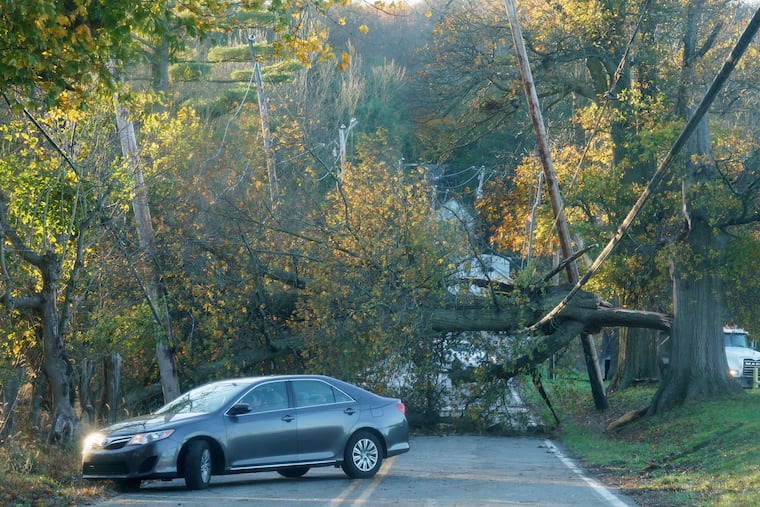How to find the best-rated tree-care services companies in the Philadelphia area
Until May 15, Delaware Valley Consumers' Checkbook is offering free online access to its ratings of tree care services to Inquirer readers.

Though they appear healthy most of the time, on occasion your trees might become shady characters, done in — and perhaps ultimately brought down — by disease or damage or both.
To keep your trees healthy or to get rid of dying ones, you may want the benefit of professional advice, skill, and labor. To help you find this help, the nonprofit consumer group Delaware Valley Consumers’ Checkbook has surveyed its members, Consumer Reports subscribers, and other randomly selected consumers about their experiences with area tree-care services. Until May 15, Checkbook is offering free access to its ratings of tree-care services to Inquirer readers via this link: Checkbook.org/Inquirer/trees.
You don’t have to be an expert to spot many potential tree problems. Examine your trees several times a year for the following:
Discolored leaves and thinning in the tree’s crown.
Roots pulled loose from the ground and fungal growths on roots and main trunk.
Dead and fallen branches more than two inches in diameter.
Deep vertical cracks on opposite sides of the main trunk.
Sawdust on the trunk from wood-boring insects.
A trunk that noticeably leans in one direction and a branch canopy that is not roughly balanced.
Other unusual deformations and deposits on leaves, limbs, or bark.
Other reasons for tree work include eliminating the risk to your house, or to electrical or other utility wires from rubbing limbs or precarious overhanging limbs; letting light and breezes more readily reach your house, garden, or lawn; and protecting foundations and drainage systems from invading roots.
In many cases, the problem and the solution will be obvious — removing specific limbs, for example. But sometimes it’s difficult to diagnose and treat trees.
At those times, you need expert advice. But don’t assume that all estimators from tree-care companies can determine what’s wrong and prescribe the correct treatment. Checkbook’s evaluation of local tree-care services found big company-to-company differences in the quality of advice and work performed. Although several area companies rate quite high for the quality of their work, the news is not all good. In addition to complaints of lousy customer service by companies that rate poorly, customers often complained of being overcharged, getting poor results, and having their property damaged by careless, untrained workers.
If you need tree-care work, the best strategy is to get more than one opinion. Invite representatives of several companies to your home to offer estimates. Ask them to explain what they plan to do and why.
Along with several opinions, you’ll get comparative pricing. Checkbook’s undercover shoppers found big differences in prices for tree-care work. For example, to remove a 32-foot oak, including removal of all wood and debris and grinding the stump, companies quoted Checkbook’s undercover shoppers prices ranging from $1,675 to $4,250. To remove a 60-foot river birch, grind the stump, and remove all debris, quotes ranged from $1,400 to $3,225.
Typically, you don’t have to be home when bidders are looking at the job — but do include a thorough description of the work in a written contract that specifies who cleans up afterward, hauls away debris and wood, and removes the stump. What is not specified in writing is very unlikely to get done.
If a job can wait, consider having the work done in winter, when companies are less busy and there is less debris to haul away.
Check whether a company’s liability insurance and worker’s compensation insurance are in effect. Ask to see certificates of insurance and call the company’s insurance carrier to verify. This is a serious concern because high-powered equipment, heavy branches and trunks, lofty heights, and proximity to power lines make tree work dangerous.
Ask about the company’s payment policy to see how much of the total cost is payable upon completion of the job or later. Paying after the work is completed gives you leverage to ensure that work is carried out properly and on time.
If you need expert advice and help caring for your trees, rather than simply removing goners, look for certification by the American Society of Consulting Arborists (www.asca-consultants.org) or the International Society of Arboriculture (www.isa-arbor.com). Certification by either organization indicates the arborist has a degree in arboriculture, several years of experience, and passed a difficult exam.
Delaware Valley Consumers’ Checkbook is a nonprofit organization with a mission to help consumers get the best service and lowest prices and does not take money from the service providers they evaluate.